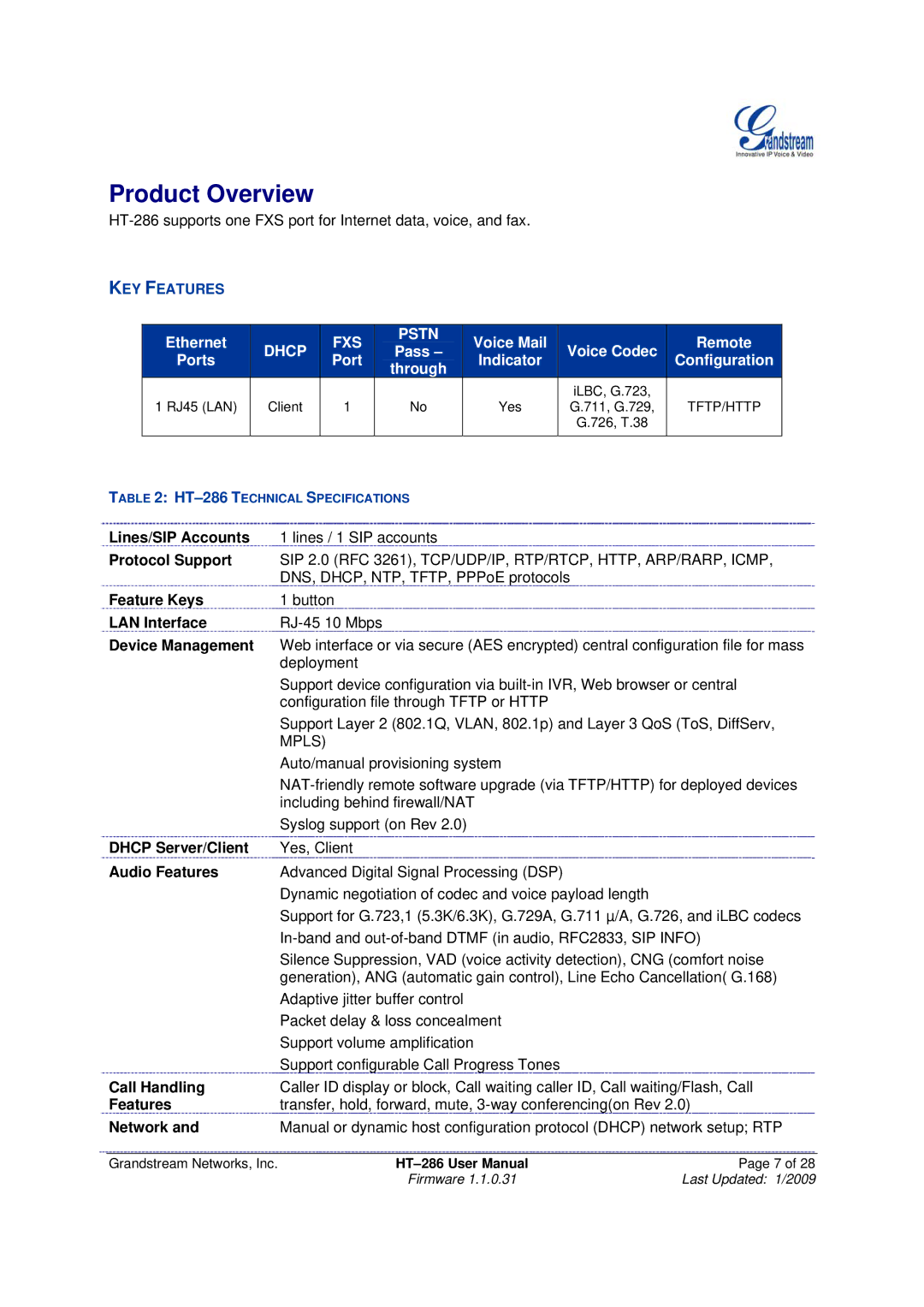
Product Overview
KEY FEATURES
|
| Ethernet |
|
| DHCP |
|
| FXS |
|
| PSTN |
|
| Voice Mail |
|
| Voice Codec |
|
| Remote |
|
| |
|
|
|
|
|
|
|
| Pass – |
|
|
|
|
|
|
|
| |||||||
|
| Ports |
|
|
|
| Port |
|
|
|
|
| Indicator |
|
|
|
| Configuration |
|
| |||
|
|
|
|
|
|
|
| ||||||||||||||||
|
|
|
|
|
|
|
|
|
|
| through |
|
|
|
|
|
|
|
|
|
|
|
|
|
|
|
|
|
|
|
|
|
|
|
|
|
|
|
|
|
| iLBC, G.723, |
|
|
|
| |
|
| 1 RJ45 (LAN) |
| Client |
| 1 |
|
| No |
|
| Yes |
| G.711, G.729, |
| TFTP/HTTP |
| ||||||
|
|
|
|
|
|
|
|
|
|
|
|
|
|
|
|
|
| G.726, T.38 |
|
|
|
| |
|
|
|
|
|
|
|
|
|
|
|
|
|
|
|
| ||||||||
TABLE 2: |
|
|
|
|
|
|
|
|
|
| |||||||||||||
Lines/SIP Accounts | 1 lines / 1 SIP accounts |
|
|
|
|
|
|
|
|
|
| ||||||||||||
Protocol Support | SIP 2.0 (RFC 3261), TCP/UDP/IP, RTP/RTCP, HTTP, ARP/RARP, ICMP, | ||||||||||||||||||||||
|
|
|
|
| DNS, DHCP, NTP, TFTP, PPPoE protocols |
|
|
|
| ||||||||||||||
Feature Keys | 1 button |
|
|
|
|
|
|
|
|
|
|
|
|
| |||||||||
LAN Interface |
|
|
|
|
|
|
|
|
|
|
|
|
| ||||||||||
Device Management | Web interface or via secure (AES encrypted) central configuration file for mass | ||||||||||||||||||||||
|
|
|
|
| deployment |
|
|
|
|
|
|
|
|
|
|
|
|
| |||||
|
|
|
|
| Support device configuration via | ||||||||||||||||||
|
|
|
|
| configuration file through TFTP or HTTP |
|
|
|
|
|
| ||||||||||||
|
|
|
|
| Support Layer 2 (802.1Q, VLAN, 802.1p) and Layer 3 QoS (ToS, DiffServ, | ||||||||||||||||||
|
|
|
|
| MPLS) |
|
|
|
|
|
|
|
|
|
|
|
|
|
|
|
| ||
|
|
|
|
| Auto/manual provisioning system |
|
|
|
|
|
| ||||||||||||
|
|
|
|
| |||||||||||||||||||
|
|
|
|
| including behind firewall/NAT |
|
|
|
|
|
|
|
|
| |||||||||
|
|
|
|
| Syslog support (on Rev 2.0) |
|
|
|
|
|
|
|
|
|
| ||||||||
DHCP Server/Client | Yes, Client |
|
|
|
|
|
|
|
|
|
|
|
|
| |||||||||
Audio Features | Advanced Digital Signal Processing (DSP) |
|
|
|
|
|
| ||||||||||||||||
|
|
|
|
| Dynamic negotiation of codec and voice payload length |
|
|
|
| ||||||||||||||
|
|
|
|
| Support for G.723,1 (5.3K/6.3K), G.729A, G.711 µ/A, G.726, and iLBC codecs | ||||||||||||||||||
|
|
|
|
| |||||||||||||||||||
|
|
|
|
| Silence Suppression, VAD (voice activity detection), CNG (comfort noise | ||||||||||||||||||
|
|
|
|
| generation), ANG (automatic gain control), Line Echo Cancellation( G.168) | ||||||||||||||||||
|
|
|
|
| Adaptive jitter buffer control |
|
|
|
|
|
|
|
|
|
| ||||||||
|
|
|
|
| Packet delay & loss concealment |
|
|
|
|
|
| ||||||||||||
|
|
|
|
| Support volume amplification |
|
|
|
|
|
|
|
|
| |||||||||
|
|
|
|
| Support configurable Call Progress Tones |
|
|
|
|
|
| ||||||||||||
Call Handling | Caller ID display or block, Call waiting caller ID, Call waiting/Flash, Call | ||||||||||||||||||||||
Features | transfer, hold, forward, mute, | ||||||||||||||||||||||
Network and | Manual or dynamic host configuration protocol (DHCP) network setup; RTP | ||||||||||||||||||||||
|
|
|
|
|
|
|
|
|
|
|
|
|
|
|
|
|
|
|
|
| |||
Grandstream Networks, Inc. |
|
|
|
|
|
| Page 7 of 28 | ||||||||||||||||
|
|
|
|
|
|
|
|
|
|
| Firmware 1.1.0.31 |
|
|
| Last Updated: 1/2009 | ||||||||
